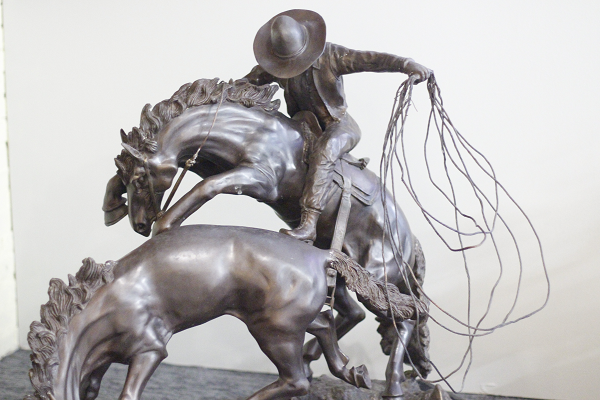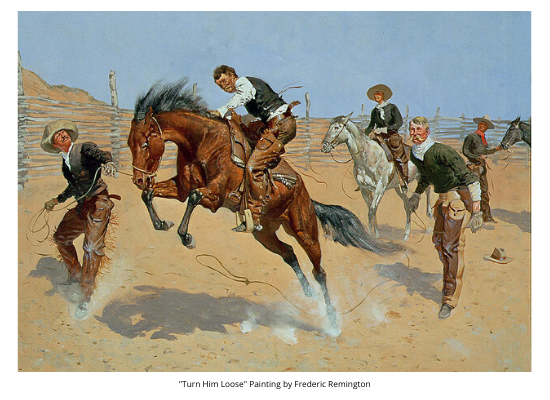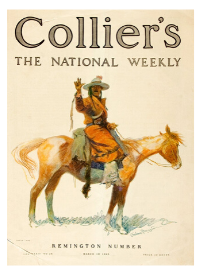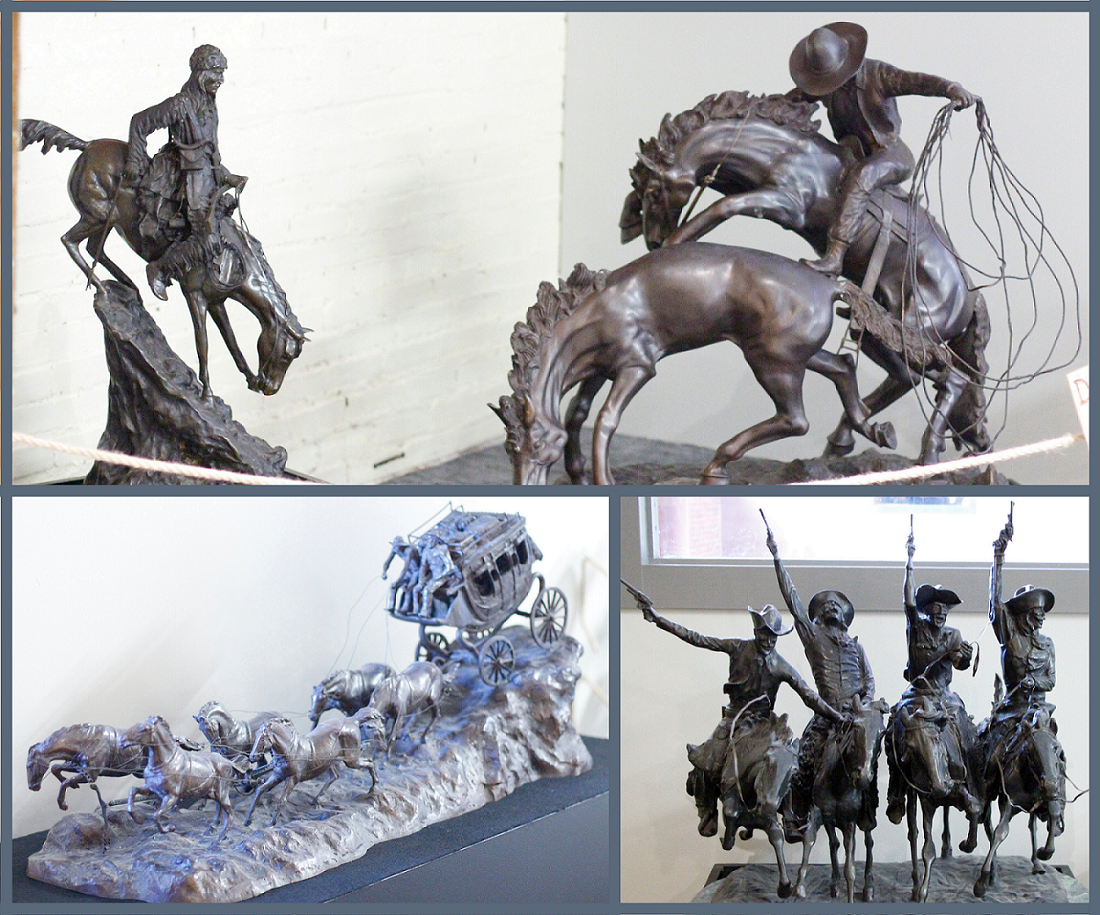An Artist’s Story: Frederic Remington
March 15, 2020

Frederic Sackrider Remington is best known for his action-packed depictions of the American Old West, both in the form of illustrations and sculptures. His sculptures and bronze casts are sprinkled throughout the U.S. today, and even fill a museum of their own (the Frederic Remington Art Museum in Ogdensburg, New York). Home to Wichita, Kansas, the Museum of World Treasures is honored to have four bronze homages to Frederic Remington and Charles Russell’s sculptures, three of which are titled “Mountain Man,” “Lassoed Mustang,” and “Coming Through the Rye.”
This is the story of Frederic Remington.
-----
For the first four years of Frederic’s life, his father was away, serving as a colonel in the Civil War. Frederic was an only child who loved to hunt, swim, ride horses, and go camping, but he struggled as a student. Rather than finding school papers worked through and strewn about, Frederic’s mother noticed that drawings and sketches of soldiers and cowboys littered the Remington house. Colonel Remington had hoped that his son Frederic would one day attend West Point, but it became clear at an early age that Frederic’s interests lied elsewhere.
.png) In 1872, when he was eleven years old, Frederic’s family moved to Ogdensburg, New York. Frederic’s parents sent him to a church-run military school called Vermont Episcopal Institute as an effort to “rein in” Frederic’s focus to that of an eventual military career. A transfer to another military school revealed that Frederic was considered “a pleasant fellow” by his classmates, as well as “a bit careless and lazy, good-humored, and generous of spirit… but definitely not soldier material” (Source). In a letter to his uncle, Frederic considered a life as a journalist with art as a side gig.
In 1872, when he was eleven years old, Frederic’s family moved to Ogdensburg, New York. Frederic’s parents sent him to a church-run military school called Vermont Episcopal Institute as an effort to “rein in” Frederic’s focus to that of an eventual military career. A transfer to another military school revealed that Frederic was considered “a pleasant fellow” by his classmates, as well as “a bit careless and lazy, good-humored, and generous of spirit… but definitely not soldier material” (Source). In a letter to his uncle, Frederic considered a life as a journalist with art as a side gig. .png)
Frederic eventually applied to and attended art school at Yale University, but quickly realized he wasn’t a fan of the traditional form of art training. He had no interest in sitting at a desk and sketching two-dimensional depictions of fruit in a bowl — he craved crafting art with action. Frederic was fascinated with the movement found in tension-filled games of football and boxing, and the first illustration he ever published was a cartoon for the student newspaper of a football player covered in bandages.
Frederic left school to be with his father, who eventually passed away from tuberculosis. After his father’s death, Frederic decided to spend some time away from school and went camping as a way to enjoy himself independently. At nineteen, he traveled west for the first time in his life. He witnessed vast, open prairies, buffalo herds that were gradually diminishing of their numbers, cattle wandering without fences to border them in, and even some of the last conflicts fought between Native American tribes and U.S. Cavalry. These same scenes that he had spent his childhood imagining and sketching as a sign of respect and admiration were before his very eyes — scenes he would reverently build from in his own creative way.
In his “in-between” years of seeing what the Old West looked like firsthand, attempting to live it, and skirting his priorities back to the path of art, Frederic:
- Moved to Peabody, Kansas, and invested all his money on starting his own sheep ranch/ wool trade (This failed — he sold his ranch after a year and returned home to his mother)
- Moved to Kansas City with more money from his mother to start his own hardware business (This also failed — due to an alleged swindle)
- Invested his remaining funds into being a half-owner of a saloon
- Married Eva Caten (This marriage temporarily failed — Eva decided early on that she disapproved of Frederic’s job, was disinterested in the sketches he regularly showed her, and left him to return to Gloversville)
With three major fails and his self-esteem at an all time low, Frederic returned to art and began to sell his artwork for essentials. His art efforts led him to success, and once he started selling paintings as a secured profession, he reunited with his wife (yay!) and the two moved to Brooklyn.
 Frederic submitted sketches, illustrations, and other publications with the Western themes he loved to Harper’s Weekly, and between 1885 and 1913, his drawings were published in forty-one periodicals. He illustrated multiple books by noteworthy authors including Henry Wadsworth Longfellow, Owen Wister, Francis Parkman, and Theodore Roosevelt, with whom he “shared a lasting friendship.” Roosevelt even commented in Pearson’s Magazine, saying:
Frederic submitted sketches, illustrations, and other publications with the Western themes he loved to Harper’s Weekly, and between 1885 and 1913, his drawings were published in forty-one periodicals. He illustrated multiple books by noteworthy authors including Henry Wadsworth Longfellow, Owen Wister, Francis Parkman, and Theodore Roosevelt, with whom he “shared a lasting friendship.” Roosevelt even commented in Pearson’s Magazine, saying:
“Remington is, of course, one of the most typical American artists we have ever had, and has portrayed a most characteristic and yet vanishing type of American life. The soldier, the cowboy and rancher, the Indian, the horses and the cattle of the plains, will live in his pictures and bronzes, I verily believe, for all time” (Source).
Throughout his travels, Remington collected observational details through sketches and photographs on the themes of cavalrymen, scouts, Native Americans, and cowboys. He relocated to New Rochelle, New York and in 1900, purchased his own small island called Ingleneuk, where he spent his summers. His art style took a surprise turn when he learned the ropes of clay modeling from Frederick W. Ruckstull, a French-born American sculptor and art critic. Frederic Remington’s sculpture “Broncho Buster,” was an instant success, “admired for its moment-in-time rendering of a cowboy astride a bucking horse” (Source). 
Over 275 authorized bronze casts were produced of “Broncho Buster,” and Frederic continued to model twenty-one sculpture groups, almost all composed of western themes. His talents of illustrating, sculpting, and storytelling through his detailed, action-infused works gained him notoriety in far more ways than he had anticipated. Even in his final years of life, Frederic modeled sculptures, managed their bronze casts, and continued illustrating. He formed an exclusive contract with Collier’s for a double-paged monthly spread of his western illustrations.
Frederic passed away at the age of forty-eight from complications following an emergency appendectomy in December of 1909. The Roman Bronze Works in New York continued to produce Frederic’s bronzes using the lost-wax bronze casting process until his wife Eva’s death in 1918. By direction of Eva’s will, the foundry destroyed the casting molds shortly after her death.

Interested in viewing these Remington and Russell bronze casts in person? The Museum of World Treasures is open from 10:00 am to 5:00 pm Monday through Saturday, and 12:00 pm to 5:00 pm on Sunday.
Want to volunteer to help preserve artifacts packed with stories of the past? Find out how you can help!
